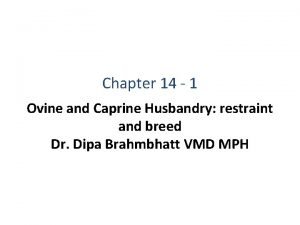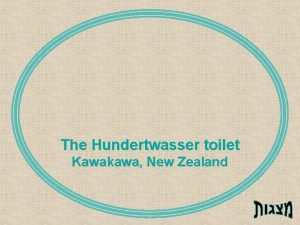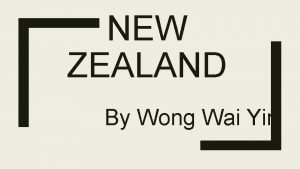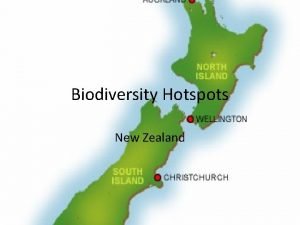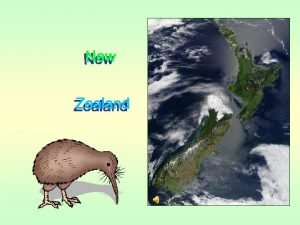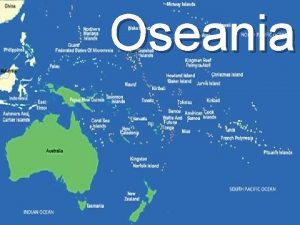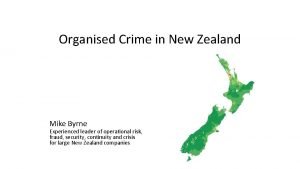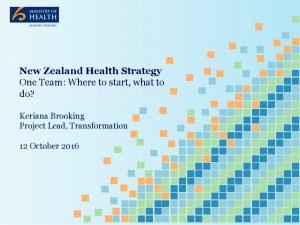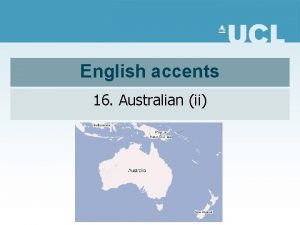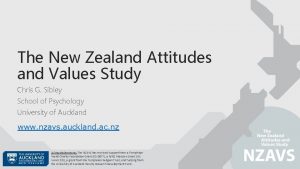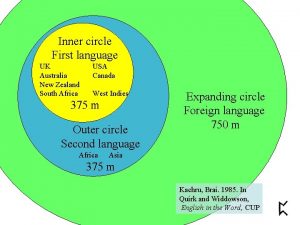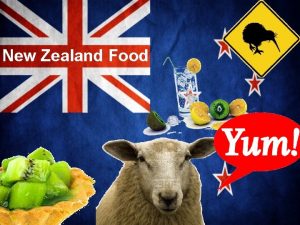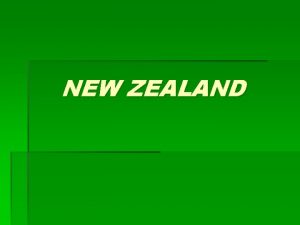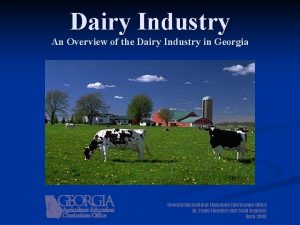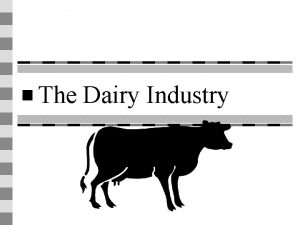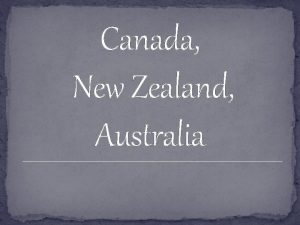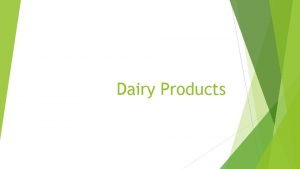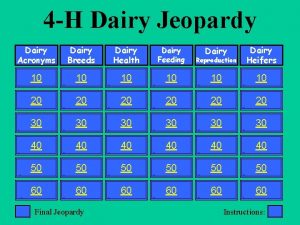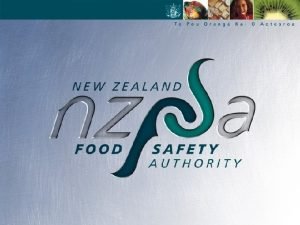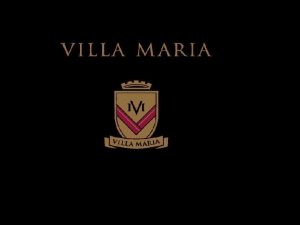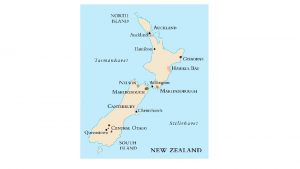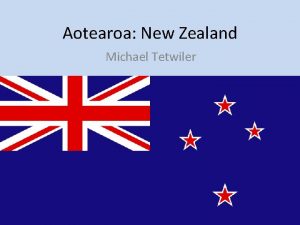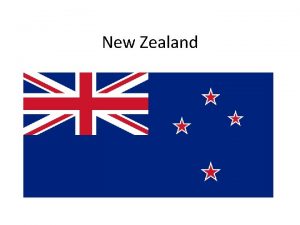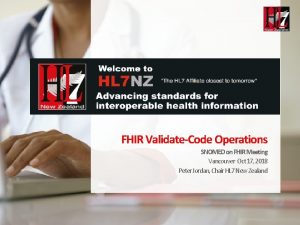New Zealand Goat Industry China Dairy Goat Conference


























- Slides: 26

New Zealand Goat Industry China Dairy Goat Conference 2017

Industry Overview • Collectively there approximately 66, 000 commercial dairy goats milked in New Zealand. At present the largest population of those dairy goats are supplying the Dairy Goat Co-operative (N. Z. ) Ltd (DGC) in Hamilton. • The goat milk industry in New Zealand is demand-led. The most valued and exported product produced is milk powder. • The Dairy Goat Co-operative (DGC) was formed in 1984 from an amalgamation of divergent goat milk co-operatives around New Zealand. • DGC’s governance structure, as a co-operative, consists of a Board with 7 directors, of whom five are elected from the shareholding suppliers and two are independent directors. The 69 supplying shareholders who supply milk to the cooperative, are the owners of the company.

Industry Overview • DGC’s milk powder is all produced on-site in its modern manufacturing facilities located in the Waikato Region. • DGC’s ownership and control of its production facilities, along with its integrated co-operative ownership model, means that supply chain integrity and quality systems are controlled, from the farm to the final product in the market. DGC No 1 Spray Drier

Industry Overview • Approx. 72% of the country’s goat population are located in the Waikato region. • Despite goat milk production in NZ being insignificant on a world scale (51, 127 tonnes in NZ vs. 18, 340, 016 tonnes worldwide), NZ developed the world’s first goat milk infant formula in 1988 and continues to be the leading international manufacturer of goat milk powders for infants and young children.

Breeds farmed in New Zealand Saanen Doe Toggenburg Doe 85% of dairy goats farmed in New Zealand are Saanen breed due to greater milk production capacity. The remaining 15% is made up of Toggenburg, British Alpine and Nubian type crosses.

Milk Production in Saanen and Crossbreed goats in NZ Breed Lactation Length (days) Saanen Average Lactation Yields (kg/doe/year) Milk Fat Protein 201 672 21. 8 20. 7 Crossbreed 252 818 27. 3 25. 6 Average production per doe for goats in NZ 234 764 25. 2 23. 7 Source: Dairy Goat Production Systems in Waikato, New Zealand. Solis-Ramirez, J. 2014

Milk Production Worldwide Country Goat Milk production (million MT) Number of dairy goats (million) Milk produced per dairy doe (kg) India Bangladesh Sudan Pakistan Spain 4. 0 2. 2 1. 5 0. 7 0. 6 30. 2 27. 1 N. A. 4. 9 1. 4 132. 5 80. 0 141. 9 422. 3 Greece 0. 5 4. 1 123. 9 Iran 0. 4 13. 7 29. 9 China 0. 3 1. 4 194. 8 New Zealand 0. 05 0. 06 800 France Somalia 0. 6 0. 4 0. 8 6. 6 703. 8 59. 7

Farming Style • The majority of dairy goats are intensively managed in open-sided barns and woodchip or sawdust covered floors. • The main goat feeds are forages such as grasses, clover, lucerne, hay, silage or pasture plants that are grown onfarm or bought in from other farms within New Zealand. • Milking goats also need other feeds that are high in protein and energy to supplement the nutrients from forages.

Farming Style • Farmers provide fresh pasture in a ‘cut and carry’ system. • Typically one-third to one-half of total forage supply for dairy goats is fresh-cut pasture. • Most dairy goat farmers are also quite reliant on grass silage as a significant component of their total forage supply system, as fresh pasture is not always available all year. • Silage is a way of dealing with the massive flush of spring pasture growth in September and October, and to make sure there are good feed resources on hand yearround, especially in February and March when grass dries off.

Caprine Arthritis and Encephalitis (CAE) is a viral disease that mainly affects dairy goats. Infection with the CAE virus is lifelong. Only a few infected animals develop clinical disease, such as chronic arthritis, mastitis, pneumonia or brain disease, but even a goat without clinical signs has a reduced productivity. It is a very slow virus and signs take a long time to appear. Goats are infected as kids when they drink colostrum from an infected doe. Infection doesn’t occur before birth. It is possible that CAE is also transmitted from goat to goat through saliva, nasal CAE positive goat showing wasting secretions, urine, and faeces. The New Zealand Dairy goat industry strives to be CAE free by the year 2022. There is no cure for CAE

Caprine Arthritis and Encephalitis (CAE) There are two main forms of the disease: nervous and arthritic. Nervous: • Signs are first seen at 1 -4 months old. The kids become increasingly weak in the back legs until they can’t walk (over days/weeks). • Initially the signs can look like a lameness. • The kid is usually bright and alert and keeps eating. • Older goats can sometimes get the nervous form too, it can look like another brain disease – cerebral listeriosis – with aimless circling and a head tilt. Arthritic: Goat suffering from CAE with a swollen knee joint. • Signs are seen between 1 -2 years old. The severity of signs ranges from severe to very mild. • Typically people will notice the knees swelling up and the goat becoming lame. The joint pain and stiffness increases over time until the goat often starts walking around on its knees.

How do we control CAE? Kids are removed immediately after birth, before they are allowed to suckle on the doe. Kids must be segregated and run as a separate herd, thereby establishing two herds. To avoid contraction of the virus a robust biosecurity plan must be in place and a closed herd maintained. All replacements are tested, whether brought in or home raised. Positive animals are not bred. If a negative buck is bred to a positive doe, the buck should then be considered positive. All equipment is kept separate for each herd, including vaccination, tattooing, hoof trimming, and drench equipment. The negative herd should be milked first.

Why Goat’s Milk? Goat’s milk has a wide range of nutritional benefits, including: • It is full of nutrients, is a good source of protein, and contains less sugar (lactose), 13% more calcium, 25% more vitamin B 6, 47% more vitamin A, and 134% more potassium than regular cow's milk. • It’s easier to digest. • It has fewer allergenic proteins and causes less inflammation. • It’s high in calcium and fatty acids but low in cholesterol. • It keeps skin looking good. • It absorbs nutrients and minerals better than cows’ milk. • Goat’s milk very closely resembles human breast milk. Because it has a chemical composition that is much closer to human milk than cow’s milk, it is easier to digest and assimilate in the human body.

Why Goat’s Milk? Compared to cow’s milk, the fat globule size in goat’s milk is significantly smaller in diameter. This results in differences in the physico-chemical structure and composition. This means that goat milk can be better digested by people who have health disorders, or a low tolerance to cow’s milk. The overall composition of goat’s milk allows it to be very versatile in many areas of human health.

Nutritional Breakdown

Requirements for Farm of Origin The goats for export must be either born and reared on the farm of origin, or that if the goats were brought into the farm they must have resident there for more than 6 months. The exporting farm must: - Have been free of Johne’s disease during the previous 3 years. - Have been free of caprine arthritis encephalitis during the previous 3 years (very limited farms meet this requirement). - Have been free of clinical symptoms of toxoplasmosis, leptospirosis and Border disease during the previous 3 years. - Have been officially free from bovine tuberculosis during the previous 3 years. These requirements for importation make procurement difficult. The only real option is to create these requirements by purchasing Does at birth, moving them, and farming for 6 months prior to entry into pre-export isolation.

How can we assist China dairy? Animal Breeding Services (ABS) offers a comprehensive range of reproductive technologies applicable to the livestock breeding industry. The company employs 25 staff in laboratory and field functions, and farms 500 hectares of farmland in support of the services it provides. Animal Breeding Services offers a range of breeding technologies for dairy and other livestock industries. They specialise in the areas of bull breeding, stud breeding, import/export and gene discovery. Some of the many services it provides are: • Semen collection centre for Rams. • Small ruminant Embryo Transfer and AI. • Genetic Exports.

How can we assist China dairy? Genetic Exports via ABS In response to global demand for New Zealand livestock genetics, ABS has developed extensive experience in exporting embryos, semen and live animals. ABS exports around 50 shipments per year and are the largest exporter of embryos from New Zealand, exporting between 6000 and 8000 embryos per year. ABS is approved by Biosecurity New Zealand for export of embryos and semen. ABS also maintains the specific approvals needed for EU, China and Chile, with a well developed infrastructure for exporting. ABS has close connections within the NZ livestock sector and frequently sources genetics according to requirements.

How can we assist China dairy? Elite Goat Genetics (EGG) is a joint venture between Yorkshire Dairy Goats, the UK’s leading producer of Goats milk , Bellevue Enterprises and Animal Breeding Services, New Zealand’s leading animal reproductive technologies specialist. EGG offers commercial milk producers the very best goat genetics from elite, genomically selected sires, backed up by dams with proven outstanding lifetime production in a large commercial herd environment. This is the first time that semen has been made available from this outstanding herd of goats and represents a unique opportunity to inject some of the worlds very best dairy goat genetics into your breeding programme.

How can we assist China dairy? Yorkshire Dairy Goats are the UK’s largest Goat Milk producer. • Closed herd of 8000 High-health Hybrid milking Goats, plus 3000 followers on two sites. • 10, 500, 000 litres sold per annum. • Herd average yield – 1350 litres per goat per annum. • Genomic selection used across herd from 2015. • Selection for robust, healthy hybrid goats has yielded consistent results over the 30 year life of the business.

How can we assist China dairy? Created by owners and staff of Elders NZ and Elders International, with the closure by Elders Australia in NZ and exiting the Livestock Export Industry in both New Zealand Australia, Pinnacle. Ag NZ is 100 percent New Zealand owned and operated. • Directors with 100 years agricultural experience. • 20 years of exporting Livestock to China. • Livestock Sourcing / Management. • Airfreight and shipping Logistics. • In country farming Management.

Importation Process Dec 2017 Contract Signing January 2019 On-farm testing required Dec 2017 Deposit payment received Feb 2019 Start of preexport isolation NZ Jan 2018 NZ Breeding Forward Contract March 2019 Aircraft Consignment June 2018 Further Security Payment required June/July 2018 Does born in NZ March 2019 Arrive China July-Jan 2018 Does reared & farmed for purchaser March 2019 China quarantine 45 days September 2018 Letter of Credit required April 2019 Arrive China farm

Import Specifications PROFORMA INVOICE Breed/Class: New Zealand Dairy Goats of the following Breeds supplied without Pedigree Saanen /Toggenburg /Nubian/ British Alpine Pregnancy: Non pregnant Age: Born in June – July 2017 7 -9 months of age at selection Weight: Minimum 35 kilos at selection in New Zealand Quantity: 1300 – 1500 head plus or minus 10 percent (delivered in consignment numbers to be determined) Inspection: Animals will be of good confirmation, healthy and free of physical defects. 105 percent pre-selected animals will be presented by the seller for inspection, selection and acceptance by the representatives of the buyer in New Zealand, within 30 days of the shipment. Delivery: By aircraft departing New Zealand before 20 th February 2019 to a nominated Port in China. Competent New Zealand stockman will accompany the consignment. Insurance: Will be obtained by the seller, covering all risks of death and/or mortality for 100 percent of CIF value covering the voyage and up until delivery to China air side Price: USD 1325. 00 per head CIF China Port.

Import Specifications Payment Terms: By deposit of 10 percent, payable by December 2017 in cash or Irrevocable confirmed Letter of Credit and payable at signing of Proforma Invoice. Another payment of USD 200. 00 per head 1 June 2018. The balance to be paid by Confirmed Irrevocable Letter of Credit payable at sight and established no later than the 1 September 2018 with a recognised international banking organisation. The seller will provide the following documents to the buyer for importation purposes and negotiation of Letter of Credit. 1. Commercial Invoice for 100 percent value 2. Zoo Sanitary Health Certificate 3. Insurance Certificate 4. Bill of Lading marked “Freight Prepaid” 5. Ear Tag Selection list signed by the buyer Conditions: 1. All costs in importing country for account of Buyer. 2. Import permit received no less than 60 days prior to shipment. 3. Contract received or provided either by the Buyer as agreed 15 days after signing of this. 4. Proforma from which time the contract will be the valid document. 5. Subject to suitable and acceptable shipping availability. 6. Agreement to terms of Letter of Credit established. 7. This PROFORMA INVOICE is valid until 20 days after signing then the seller has the right to review any pricing terms and conditions contained within it or the signed contract will be the valid document.

Waikato Milking Systems is a leading designer and manufacturer of dairy technology. They are a 100% New Zealand owned and operated company with global reach. They have products available around the world, with four manufacturing divisions that give them total control over design and manufacturing. This means they can provide complete milking solutions while also giving careful attention to the small details that can have such a big impact on a finished project. • Partnership opportunity available. • Access to a turn-key farm approach. • Milking equipment / Goats as one package. • Deal with only one entity to access complete farm set up. • Very limited opportunity to access Dairy Goats.

Milking Process
 Spanish nanny goat
Spanish nanny goat Kawakawa toilets
Kawakawa toilets New zealand national sport
New zealand national sport New zealand disability strategy
New zealand disability strategy Wong wai yin
Wong wai yin Difference between australian and new zealand accent
Difference between australian and new zealand accent Lesson 1 an introduction to oceania
Lesson 1 an introduction to oceania New zealand alpha lipid colostrum
New zealand alpha lipid colostrum New zealand hot spot
New zealand hot spot Aotearoa the land of the long white cloud
Aotearoa the land of the long white cloud What is the capital of new zealand
What is the capital of new zealand Natives of new zealand
Natives of new zealand Urfolk new zealand
Urfolk new zealand Mike yin new zealand
Mike yin new zealand New zealand health strategy 2016
New zealand health strategy 2016 New zealand holiday 2016
New zealand holiday 2016 New zealand vs australian accent
New zealand vs australian accent Nurse anesthetist new zealand
Nurse anesthetist new zealand Saurabh paranjape location
Saurabh paranjape location New zealand values and attitudes
New zealand values and attitudes Measurement standards laboratory of new zealand
Measurement standards laboratory of new zealand Inner circle
Inner circle Internal medicine society of australia and new zealand
Internal medicine society of australia and new zealand Thesis statement example
Thesis statement example New zealand
New zealand New zealand population
New zealand population Kumara new zealand food
Kumara new zealand food
